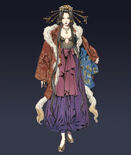| Tamamo | |
| Weapon(s): | Scroll
|
| Type: | Wonder |
| First Appearance: | Warriors Orochi 3 Ultimate |
| Real name: | Tamamo no Mae
|
| Chinese/Japanese name: | 玉藻前
|
| Mythological figure. Name alternatively spelled as 化生の前 or 玉藻の前. Also known as Tamamo Gozen (玉藻御前). | |
Tamamo no Mae is a mythological Japanese figure from the late Heian period. She is either a two or nine-tailed fox who is known for her beauty and wicked cunning. Japanese folklore may compare her to Daji or state that Tamamo is a Japanese pseudonym for her. This version is often defeated by Seimei or his descendants or by Taigong Wang.
Koei's Japanese themed games often includes the Killing Stone as a collectible item. This page seeks to include the instances when she has physically appeared in the games.
Her Warriors Orochi counterpart is designed by Akihiro Yamada. She is unlocked by finishing the final battle in Chapter 8.
Role in Games
Tamamo appears in the dimensional realm after Hydra's defeat as a mysterious rock found by the remaining members of Orochi's forces. Through the powers of a mysterious scroll and a relic known as the Shinkyō, she enjoys toying with the warriors like they are her personal puppets. She joins forces with the resurrected Orochi and Da Ji, all the while following her own agenda.
First appearing in Nanjun, Tamamo seals Nobunaga and his allies inside her mirror upon facing them. She eventually overshadows Da Ji as a major antagonist throughout the story. In one ending, the Three Divine Sovereigns use their combined powers to seal her back into stone. The same event also occurs in her special stage where she is tricked into being surrounded by her own allies.
When the heroes travel into Fu Xi's past, they learn that Tamamo is responsible for causing Yinglong's fall and destroying the Jade Emperor's mirror. Clearing this chapter opens up a new battle where the heroes use the Shinkyō on Tamamo, forcing her to transform into her true form.
Character Information
Personality
Tamamo is an elegant woman who shares Da Ji's cunning and intellect. She prefers to spout soothing advice with frigid impassiveness for her manipulations, forgoing the overt playfulness of her counterpart. She also has an affinity with Seimei, Sun Wukong, and Yinglong.
Character Symbolism
The majority of her weapons are names of flowers which often use beauty and impermanency as their themes. Her first weapon refers to lush fields of unspecified flowers, while her second is an archaic name for the Japanese glorybower. The particular spelling roughly translates as "scarlet foxglove tree", which genus it was once thought to resemble. Within the Japanese flower language it means "to become happy". It often ties into the foxglove tree's meanings of loftiness and dignity, both with connotations of them being short-lived. Her second five-star weapon references cherry blossoms.
Tamamo's third weapon is a reference to the Asiatic dayflower. Her weapon uses another name, hanadagusa, to describe its vibrant appearance. Hanada was once reputed in ancient Japan as an elusive blue found only on the Asiatic dayflower. Dyers could not easily replicate the shade without heavily combining violet and red dyes together; even then, the results were randomized and temporary. The slightest bit of moisture could ruin it. Its dying process was considered so difficult that it became legendary. Heian period poetry equated the color to elusive glory since only the richest nobles dared to replicate it again on cloth.
Her fourth weapon is the golden orchid, a spring flower typically found in Eastern Asia. I Ching uses the same characters to describe forgiveness and intimate friendships. It is often characterized as an ill-fated beauty within the Japanese flower language due to its fickle reproductive phases. A single plant can sprout several eye-catching blossoms, but they will rarely be pollinated.
Voice Actors
- Yuka Komatsu - Warriors Orochi 3 Ultimate
Quotes
Gameplay
| Keys: |
Ground Moveset
- R1: Twirls scroll to cast a buff spell on self for thirty seconds.
 , R1: Causes scroll to circulate around Tamamo, conjuring symbols that knock nearby foes off their feet.
, R1: Causes scroll to circulate around Tamamo, conjuring symbols that knock nearby foes off their feet. :
: (True):
(True):
Horse Moveset
 : Horse rears on hind legs before smashing the ground with their front hoofs. If the horse is sprinting, it will perform a long jump instead.
: Horse rears on hind legs before smashing the ground with their front hoofs. If the horse is sprinting, it will perform a long jump instead. ,
,  :
: ,
,  ,
,  :
: ,
,  ,
,  ,
,  :
: : Horse stampedes with a powerful aura.
: Horse stampedes with a powerful aura.
Fighting Style
Weapons
Warriors Orochi 3 Ultimate
| (深草巻) | |
|---|---|

|
Base Attack: 6 |
| Compatibility Bonus: 7 | |
| (緋桐巻) | |

|
Base Attack: 9 |
| Compatibility Bonus: 11 | |
| (縹草巻) | |

|
Base Attack: 14 |
| Compatibility Bonus: 14 | |
| (金蘭巻) | |

|
Base Attack: 25 |
| Compatibility Bonus: 18 | |
| (真・金蘭巻) | |

|
Base Attack: 60 |
| Compatibility Bonus: 18 | |
| (仙雲絵巻) | |

|
Base Attack: 55 |
| Compatibility Bonus: 18 | |
Acquiring Mystic Weapon
- Stage: Chapter 7 - Mystic Realm Escape
- Requirements: Defeat Fu Xi, Vulpecula, and Wen Zhong in under 5 minutes.
Big Star Weapons
Tamamo uses the following big star weapons in the game.
- Fortune Roll
- Golden Cherry Roll
Japanese Folklore
Tamamo no Mae is believed to be roughly based on Fujiwara no Nariko, the Queen Consort of Emperor Toba. Both figures were highly favored by their parents and their respective emperors as "truly magnificent" of surreal quality. The Queen Consort was fabled to have plotted for her child to become the heir apparent, causing a bloody rebellion between Emperor Toba's other potential heirs. Tamamo, in her incarnation for the Killing Stone, recalled witnessing a similar massacre in one of her many lifetimes. Whether this is true or not remains to be seen, but it is a popular story.
Her origins and past vary based on the time era in which the tale was made. The Heian and Muromachi versions insist that she was born in Japan during the same era as her prey. These tales state that she was a former commoner of no noble origins.
The Edo period stories are famous for depicting her as one of the most villainous women in folklore and one of the three most evil spirits, sharing the right with Shuten-dōji and Emperor Sutoku. She was alive since 5th century BC in ancient India, leading to the (debunked) claim of her being the oldest malevolent fox spirit to have existed. She used her allure to be favored by a Chinese king or prince named Banzu (班足王 or 班足太子) and became his concubine, Lady Hanyang (華陽夫人). Without his knowledge, she hypnotized him to be her puppet and took the heads of thousands of innocent people to feed herself. The angry commoners led a resistance against the king and caused his downfall. Using her powers, she fled the carnage and hid for several hundred years within the mountains. When she gained the courage to descend, she became King Zhou's concubine (Daji). When the kingdom fell, she once again resumed her centuries of hiding before her next emergence. Alternatively, her true identity was immediately exposed by Taigong Wang, who then used his divine sword to split her fleeing body and spirit into three.
Her spirit was reborn –or she later assumed the name– Bao Si, the famous concubine of King You. Under this identity, she refused to smile until the signal fires to call the army to arms was lit. Captivated by the radiance of her smile, the king would continue to light the fire without reason for her. His favoritism for her caused the governing to suffer and led to discontent with his generals. She quietly slipped away from the public eye during the chaotic uprising which followed and returned to her life of hiding for many years. In 753, she assumed the identity, Wakamo (若藻), to bewitch Kibi no Makibi. Using the minister's connections with China, she boarded one of his boats and, through her discreet use of her supernatural powers, they were able to arrive in Japan without incident.
Regardless of the version, Tamamo was known for her perilous beauty and was reputed to have had no equal in the land. Her skin was so pure it illuminated, her clothes were never dirtied, and her gait had surreal elegance that no living being could ever hope to replicate. Her looks were magnified by her peerless intelligence, as she never erred when she spoke and answered anything asked of her with perfect accuracy. Her parents were marveled by her qualities and named her Mizukume (藻女), or "splendid girl".
When she turned 18, she was sent to become a servant for the imperial palace. Before long, her charms were noticed by the court and drew Emperor Konoe's attention. Falling for Mizukume at first sight, he immediately had her made as his attendant. Her new title became Tamamo no Mae (literally translated as "Splendid Gem of the Past") to reflect his feelings for her. Emperor Konoe lavished her with his affections and soon never wanted to part from her. Around the same time, he began to become very ill. Expert herbalists were powerless and could not treat him. It was an onmyouji from the Abe sect who correctly identified Tamamo to be the cause –the onmyouji changes in sources between Abe no Yasuchika, Yasunari, or Seimei. Depending on the source, she was also Seimei's biological mother. He chanted a mantra to reveal her identity as a golden nine-tailed fox spirit, and Tamamo fled before she could be struck down by guards.
She fled toward the Nasano district and an army of 8,000 was called to hunt her. Abe served as their strategist and Miuranosuke Yoshiaki, Chibanosuke Tsunetane, and Kazusanosuke Hirotsune served as the generals. Sudōgō-no-Kami Sadanobu was called for assistance. The nine-tailed fox remained in her true form so she could use her sorcery to deflect their arrows. At first, she seemed superior to them, but the Abe onmyouji countered her tactics at each turn. Mounted archers normally used for hunting dogs had the advantage over her.
During the night, the nine-tailed appeared as a beautiful girl in Sadanobu's dream to plead for forgiveness. The hunters considered it a sign of the fox's powers weakening and advanced their troops. As the fox tried to flee, Miuranosuke landed two arrows on its neck and posterior. Kazusanosuke drew his long blade to slay it. Depending on the version of the tale, the fox continued to plea for forgiveness to Miuranosuke because she considered him the strongest yet weakest willed of the lot. Emperor Konoe made a healthy recovery after the fox's death and the people rejoiced. Many valuable treasures were found within the fox's body and brought back to the palace. The hunters received high honors and were handsomely rewarded.
Edo period folklore instead states that the fox's carcass instantly transformed into a large poisonous stone. Any living being which came into contact with it perished, thus it was dubbed the "Killing Stone". It continued to exist after Emperor Konoe's death, causing many people to fear its presence. Several pious figures attempted to purify it but fell victim to the stone's strong miasma, losing their lives to it as well. It wasn't until a monk named Gennō Shinshō came to the stone and was implored by Tamamo's spirit to grant her respite. After he performed the final rites for her, her soul left the stone and it became harmless.
Gallery
| This Warriors Orochi related article is a stub. You can help the wiki by expanding it. |






